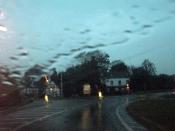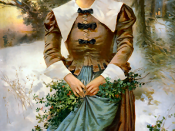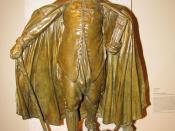Hawthorne starts off the piece with beautiful imagery that takes you back to a time of idealism and gaiety. He personifies Midsummer Eve as a woman with roses in her lap, bringing lush vegetation to Merry Mount. He then goes on and describes the seasons as teasing friends, enjoying the company of each other. This beautiful use of personification sets the mood of the story, he weaves this beautiful, idealistic, fairy-tale environment to show exactly how perfect and gay Merry-Mount is. However, this can also be a foreshadowing of the tragedy that is to come.
He uses very colorful language in his description of the may-pole. He uses an analogy comparing the colors of the banner to the rainbow. Again he personifies the surroundings to underscore the gaiety and happiness of Merry Mount. He writes that the garden flowers and blossoms laughed gladly forth amid the verdure.
However his third paragraph, in which he describes the people seems critical.
He compares the people to Gothic monsters and calls them the Salvage Men. It seems that he is criticizing them for the corruption they are entrenching themselves in. But when he talks about the Lord and Lady of the May, the adjectives he uses are very positive. He calls them youthful, lightsome, jovially. This is drastically emphasized when his adjectives suddenly take a critical turn and he says the priest is dressed in a heathen fashion and seemed to be the wildest monster there.
His most effective line in the whole piece was "Should the grisly saints establish their jurisdiction over the gay sinners, then would their spirits darken all the clime, and make it a land of clouded-visages, of hard toil, of sermon and psalm, forever." This one line provides many entities to be inferred. Firstly, this line expresses...


